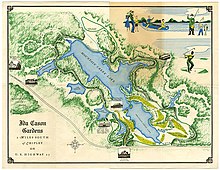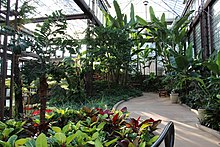Callaway Gardens
[9] When the Great Depression struck in 1929, much of Harris County land was former cotton fields that were "worn out", depleted of nutrients after nearly 100 years of cultivation.
[10] Callaway originally conceived of developing the garden in 1930 after he discovered a rare azalea, Rhododendron prunifolium (plumleaf), growing in the area.
After serving in the Korean War, their son Bo Callaway returned to Harris County, Georgia to help his parents develop and run the gardens.
The 3,000-acre (1,200 ha) Cason J. Callaway Memorial Forest opened in 1972, and was designated a National Natural Landmark by the United States Department of the Interior.
[14] The Ida Cason Callaway Foundation applied for and was granted conservation easements on land in 2004 and 2007 by the Georgia Forestry Commission.
Calloway had just turned 60 and wanted to find a leader with "expertise to take the gardens and resort to the next level with new programming and branding efforts".
[24] The gardens closed temporarily following Hurricane Irma in September 2017, as it downed hundreds of trees and left the area without power.
[27] During Doyle's tenure he closed two popular major attractions that had been open for 30+ years: Sibley Horticultural Center.
The Ida Cason Callaway Foundation decided that selling large tracts of land was the best way to reduce debt.
CEO Edward Callaway stated that the Gardens were now "on sound financial footing" with total debt down to $7.5 million, which he called a "sustainable level".
[38][39] Although Edward Callaway claimed that the gardens finances were stable following the 2012 land sales, there were deeper cuts to be made.
Two popular major attractions, Mr. Cason's Vegetable Garden and the Sibley Horticultural Center were closed in late October and early November 2015.
It created a clear line of sight between the hotel and the water plus a view of land in the F. D. Roosevelt State Park.
Local quarried stone was used extensively including the property entrance & gatehouse, pathways, pool & koi pond, plus fireplaces.
[42] Built using the Adirondack style and designed by Ivey and Crook, it played host to three US Presidents, including FDR and was listed in the National Register of Historic Places before being left to the Ida Cason Callaway Foundation.
[10] The property around the estate is owned by Dan Amos, Jeff Foxworthy, Bill Jordan and Joe Rogers Jr., some of whom purchased tracts from the Ida Cason Callaway Foundation.
Herschend will also lease and manage the Virginia Hand Callaway Discovery Center, the Ida Cason Memorial Chapel, the Cecil B.
Fran Rogers, Board Chairwoman for the Ida Cason Callaway Foundation, was quoted, "This is an exciting and important milestone for the Foundation — one that assures we can continue our philanthropic efforts in the community and continue Cason and Virginia Callaway’s vision of ‘creating a garden so beautiful that it would make visitors want to go home and lead better lives,’ for generations to come.”.
We are wholeheartedly committed to preserving and strengthening all that makes Callaway so beloved and special — and look forward to celebrating the area’s natural beauty with a focused effort on world-class events and activities that complement the surrounding landscape.
Show attendees can learn about different raptors from a bird handler and see them fly from their aviary to perches around the arena, then receive a reward.
It was dedicated on April 12, 1962[55] by Dr. Norman Vincent Peale,[56] "to the glory of God, and in loving memory of Ida Cason Callaway.
"[57] Constructed using regional materials such as fieldstone quartz, massive pine beams and a slate roof, it was inspired by Gothic architecture.
A November 2, 2015, article in the Atlanta Business Chronicle stated, "There are plans to move the garden elsewhere, but a decision has not yet been made regarding the location and size.
"[29] In a November 9, 2015, Columbus Ledger-Enquirer article, then-President & CEO Bill Doyle said the vegetable garden land might end up being the site of a golf course clubhouse or a hotel or both.
Because the center contained a production greenhouse and was a top display conservatory, their research, internship and educational programs had a profound impact over 30+ years.
[61] The goal of the Sibley Horticultural Center was "an expression of man working in harmony with nature while addressing the needs and wants of both plants and people".
In 2011 CEO Edward Callaway said the facility looked “old and tired,” attracting neither individuals or group travelers.From late 2012 to 2014 a $2.5 million in renovations was spent at the Mountain Creek Inn to upgrade rooms and the lobby.
[21][63] Renovation for the 30,000 sq ft (2,800 m2) Lodge conference center was scheduled to begin in late 2019 and be ready in February 2020.
The smaller pool sat right outside what was then called the Plantation Room Restaurant which was replaced with a paved courtyard and a koi pond.
When asked what happened to the pool, a waitress responded, "I think some of the older ladies didn’t appreciate their husbands ogling over bathing beauties during their meals.








